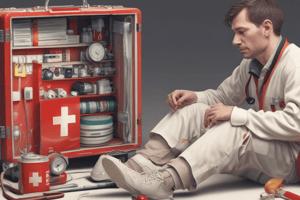Podcast
Questions and Answers
Match the medical terms with their definitions:
Match the medical terms with their definitions:
Stroke = Cerebrovascular accident (CVA) Diabetes Mellitus Type I = Body does not produce insulin Hypoglycemia = Low blood sugar Dehydration = Excessive loss of water
Match the conditions with their potential risks:
Match the conditions with their potential risks:
Hyperglycemia = Diabetic coma Hypoglycemia = Can be life-threatening Internal bleeding = Caused by trauma Stroke = Ischemic nature can lead to severe deficits
Match the type of Diabetes Mellitus with its description:
Match the type of Diabetes Mellitus with its description:
Type I = Requires insulin injections Type II = Managed by diet and exercise Hypoglycemia = Dangerously low blood glucose Hyperglycemia = Elevated blood glucose levels
Match the medical response with the appropriate scenario:
Match the medical response with the appropriate scenario:
Match the symptoms associated with Diabetes Mellitus:
Match the symptoms associated with Diabetes Mellitus:
Match the condition with its characteristic feature:
Match the condition with its characteristic feature:
Match the terms with their related treatments:
Match the terms with their related treatments:
Match the complications with their related diseases:
Match the complications with their related diseases:
Match the risk factors with the disease:
Match the risk factors with the disease:
Match the warning signs with their significance:
Match the warning signs with their significance:
Match the medical emergency with its description:
Match the medical emergency with its description:
Match the type of shock with its cause:
Match the type of shock with its cause:
Match the condition with its symptom:
Match the condition with its symptom:
Match the emergency response to its situation:
Match the emergency response to its situation:
Match the injury to its first aid step:
Match the injury to its first aid step:
Match the type of burn with its severity:
Match the type of burn with its severity:
Match the first aid procedure with its relevant medical emergency:
Match the first aid procedure with its relevant medical emergency:
Match the symptom with the emergency condition:
Match the symptom with the emergency condition:
Match the cardiogenic concern with its definition:
Match the cardiogenic concern with its definition:
Match the medical emergency with its potential complication:
Match the medical emergency with its potential complication:
Flashcards are hidden until you start studying
Study Notes
Basic Principles of Management in a Medical Emergency
- Effective management is crucial in emergencies to stabilize patients and ensure safety.
Signs, Symptoms, and General Management of Selected Medical Emergencies
External Bleeding/Lacerations
- Control bleeding through direct pressure and elevation of the affected area.
Shock
- Defined as inadequate blood pressure and oxygen delivery to tissues.
- Low circulating blood volume significantly reduces blood pressure.
- Four types of shock include hypovolemic, cardiogenic, distributive, and obstructive.
Orthostatic (Postural) Hypotension
- Sudden drop in blood pressure due to position changes, leading to dizziness or fainting.
- Blood pools in lower extremities when standing.
- Common symptoms include lightheadedness, nausea, and cold sweats.
Fractures
- Immobilize the affected area to prevent further injury.
- Monitor for signs of shock and neurovascular status.
Burns
- Prioritize preventing wound contamination, pain management, and shock prevention.
Seizures
- Ensure safety by protecting the person from injury.
- Maintain patient's modesty and privacy during the episode.
Choking
- Apply CPR if necessary, utilizing the Heimlich maneuver to clear the airway.
Autonomic Dysreflexia
- Characterized by an exaggerated sympathetic nervous system response to stimuli.
- Manage by identifying and eliminating the noxious stimulus.
Cardiac Arrest/Myocardial Infarction (MI)
- Caused by decreased blood flow and oxygen to the heart, often due to coronary artery obstruction.
- Conscious patients should be calm and supported in a comfortable position; administer oxygen and medication as appropriate.
- Unconscious patients require immediate CPR (CAB method) and 911 call.
Stroke (Cerebrovascular Accident)
- Early recognition of symptoms is critical for minimizing damage; TPA can be effective within 3 hours for ischemic strokes.
- Public education encourages awareness of warning signs, sometimes referred to as "brain attack."
Internal Bleeding
- Often results from trauma; requires swift assessment and potentially life-saving interventions.
Diabetes Mellitus (DM)
- A chronic condition marked by high blood sugar levels due to insulin production issues.
- Long-term consequences include cardiovascular disease, kidney failure, and nerve damage.
- Two types:
- Type I (IDDM): Requires insulin injections due to total lack of production.
- Type II (NIDDM): Managed through lifestyle changes; ineffective use of produced insulin.
Hypoglycemia
- Life-threatening condition indicated by low blood sugar levels; requires prompt treatment.
Hyperglycemia
- High blood sugar levels can lead to diabolic coma if untreated; requires immediate management.
Dehydration
- Results from excessive water loss or inadequate intake; can cause hypovolemia and shock if not addressed.
Studying That Suits You
Use AI to generate personalized quizzes and flashcards to suit your learning preferences.



